CONTENTS
Commentary on Chapter 3 "The Orthodox Doctrine of the Great Vehicle"
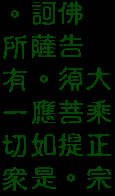 The Buddha told Subhuti, "All Bodhisattvas, Mahasattvas,
should thus subdue their hearts with the vow, I must cause
all living beings -- those born from eggs, born from wombs, born from moisture,
born by transformation; those with form, those without form, those
with thought, those without thought, those not totally with thought,
and those not totally without thought -- to enter Nirvana without residue
and be taken across to extinction.
Yet of the immeasurable, boundless
numbers of living beings thus taken across to extinction, there is
actually no living being taken across to extinction. And why? Subhuti,
if a Bodhisattva has a mark of self, a mark of others, a
mark of living
beings, or a mark of a life, he is not a Bodhisattva."
The Buddha told Subhuti, "All Bodhisattvas, Mahasattvas,
should thus subdue their hearts with the vow, I must cause
all living beings -- those born from eggs, born from wombs, born from moisture,
born by transformation; those with form, those without form, those
with thought, those without thought, those not totally with thought,
and those not totally without thought -- to enter Nirvana without residue
and be taken across to extinction.
Yet of the immeasurable, boundless
numbers of living beings thus taken across to extinction, there is
actually no living being taken across to extinction. And why? Subhuti,
if a Bodhisattva has a mark of self, a mark of others, a
mark of living
beings, or a mark of a life, he is not a Bodhisattva."
In Mahayana Buddhism, the love and compassion of a Buddhist towards other creatures, or more generally, all other living beings, are considered as the highest priority. A Bodhisattva is to offer the merits he/she develops from the good deeds for the good of others. This is the so-called 'great vehicle': a great vehicle to take across all living beings to enlightenment. In this chapter, the Buddha expounds on the vow of a Bodhisattva or Mahasattva (a great Bodhisattva), whose ideal is to become a Buddha, but is willing to forego entering Nirvana himself/herslf in order to remain in this world as long as there are other living beings to be saved from suffering.
In connection to the living beings to be saved, the Buddha mentions about their categories as well as the ways of categorization of them: the first way into 4 categories (born from eggs, born from wombs, born from moisture, born from transformation); the second way into 2 categories (those with form, those without form); the third way into 2 categories (those with thought, those without thought) or 3 categories (those with thought, those without thought, those not without thought).
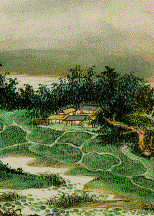 The vow of a Bodhisattva is to cause all these living beings to enter Nirvana before he/she would enter
Nirvana himself/herself. Moreover, the Buddha said,"to enter Nirvana without residue and be taken across
to extinction". Here the meaning of 'Nirvana without residue' and 'taken across to extinction' require
some elaborations.
The vow of a Bodhisattva is to cause all these living beings to enter Nirvana before he/she would enter
Nirvana himself/herself. Moreover, the Buddha said,"to enter Nirvana without residue and be taken across
to extinction". Here the meaning of 'Nirvana without residue' and 'taken across to extinction' require
some elaborations.
There are 4 types of Nirvana:
There are 2 types of obstacles:
There are 2 types of birth and death:
The Bodhisattva will cause all living beings to use the wisdom of Prajnaparamita, first to perceive the emptiness of the self in order
to overcome the first type of obstacle and stay away from the first type of birth and death (in separate sections); second, to perceive the emptiness of dharma in order to
overcome the second type of obtacle and stay away from even the second type of birth and death (in other lives). In this way, the beings are taken across to
extinction and to enter the Nirvana without residue.
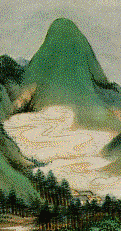
The Buddha goes on to stipulate that "of the immeasurable, boundless numbers of living beings thus taken across to extinction, there is actually no living being taken across to extinction". In other words, although the Bodhisattva has taken numberless of living beings to extinction (i.e. entered into Nirvana without residue), there are actually no living beings taken across. This sounds like a paradox. But in fact, this is a manifestation of the ontological voidness, the basic principle in prajnaparamita. It is because that from the prajna wisdom, there is no difference between a Buddha and an ordinary living being. Therefore there are actually no living beings to be taken across. Moreover, since all beings already possess the nature of a Buddha, a Buddha and an ordinary living being are equal in their self-nature, and in the final analysis, there is actually no difference between affliction and bodhi, between birth/death and Nirvana. In this way, a Bodhisattva does not see that there are beings to be saved ! The idea of inequality does not exist in the mind of a Bodhisattva. Therefore, there is no living being taken across to extinction.
The Buddha goes on to point out explicitly that "if a Bodhisatva has a mark of self, a mark of others, a mark of living beings, or a mark of a life, he/she is not a Bodhisattva". The four marks described here are elaborated as follows:
Since a Bodhisattva does not see the mark of self nor the mark of others, when he/she takes across the others, he/she would not cling on to any form of existence. By real mark prajna, there is not a slightest notion of inequality: "Dharma is level and equal, with no high or no low". A true Bodhisattva has no mark of the self and thus can take across all living beings to extinction. That is how a Bodhisattva can subdue his/her heart by relinguishing the four marks. That is why the Buddha said that if a Bodhisattva has any of the marks, he/she is not a Bodhisattva.
The Basic Practice of a Bodhisattva
Commentary on Chapter 4 "Wonderful Conduct without Dwelling"
"Subhuti, what do you think, is space in the east measurable?"
"No, World Honored One."
"Subhuti, is space in the south, west, north, or in
the intermediate directions, or above, or below, measurable?"
"No, World Honored One."
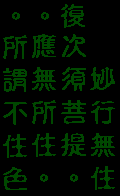 "Moreover, Subhuti, as to dharmas, a Bodhisattva
should not dwell anywhere when he gives. He should not dwell in forms
when he gives, nor should he dwell in sounds, smells, tastes, tangible
objects, or dharmas when he gives. Subhuti, a Bodhisattva should give thus:
he should not dwell in marks when he gives, his blessing and virtues are
immeasurable.
"Moreover, Subhuti, as to dharmas, a Bodhisattva
should not dwell anywhere when he gives. He should not dwell in forms
when he gives, nor should he dwell in sounds, smells, tastes, tangible
objects, or dharmas when he gives. Subhuti, a Bodhisattva should give thus:
he should not dwell in marks when he gives, his blessing and virtues are
immeasurable.
"Subhuti, the blessings and virtue of a Bodhisattva
who does not dwell in marks when he gives are just as immeasurable.
Subhuti, a Bodhisattva should only dwell in what is taught thus."
The Buddha talks about how "as to Dharmas, a Bodhisattva should not dwell anywhere when he/she gives". Here, the Buddha starts describing how a Bodhisattva practice the paramitas in his/her wonderful conduct. The first of the Six Paramitas is the practice of giving. A Bodhisattva should get rid of any attachment while giving: anything associated with the act of giving is 'empty'. This is known as the "Threefold Purity" or "the Emptiness of the Substance of the Three Wheels", which means the absence of:
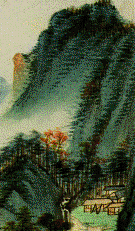 One should not have the thought:"I practice giving and have done so many meritorious and virtuous deeds". If so, one is still
attaching the mark of giving and no matter how much have been given away, the merits and virtues incurred are limited and
will run out eventually. On the other hand, if one can give without mark, the merits and virtues are limitless. In other words,
the act of giving should be performed so naturally that one would not think about it at all. This is the genuine giving.
One should not have the thought:"I practice giving and have done so many meritorious and virtuous deeds". If so, one is still
attaching the mark of giving and no matter how much have been given away, the merits and virtues incurred are limited and
will run out eventually. On the other hand, if one can give without mark, the merits and virtues are limitless. In other words,
the act of giving should be performed so naturally that one would not think about it at all. This is the genuine giving.
Similarly, a Bodhisattva will practice the other five paramitas, namely, taking precepts, endurance, vigor, meditation and prajna, all without marks. Moreover, a mark is not just a notion of form, it is also the first of the Six Dusts (i.e. the Six Objects). Therefore, the way of practicing anything without a mark should also apply to the notions of the other Objects: sounds, smells, tastes, tangible object and Dharma. So, when a Bodhisattva practices any of the paramitas, he/she should not dwell in any of the objects.
Later in this chapter, the Buddha elaborates that giving without marks will result in immeasurable blessings. At the end, the Buddha concludes that a Bodhisattva should only dwell in what is taught "thus". This is the follow-up to the answer the Buddha gives in Chapter 2 "One should thus dwell" in response to the question "how to dwell and subdue our heart ?", meaning that one should rely on the self-nature and start from the prajna wisdom originally residing in ourselves and to dwell in "thus" and "thus" subdue our heart.
Commentary on Chapter 5 "The 'Thus' Principle of Genuine Seeing"
"No, World Honored One, the Tathagata cannot be seen by his physical marks. And why?
It is because the physical marks are spoken of by the Tathagata as no physical marks."
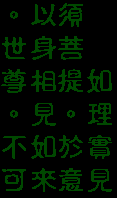 "Subhuti, what do you think, can the Tathagata be seen by his physical marks?"
"Subhuti, what do you think, can the Tathagata be seen by his physical marks?"
The Buddha said to Subhuti, "All with marks is empty and false. If you can see all
marks as no marks then you see the Tathagata."
This chapter elaborates on the fundamental principle of Emptiness. Instead of waiting for a question from Subhuti, the Buddha challenges him with the question: "Can the Tathagata (a Buddha) be seen by his physical marks ?"
Subhuti, being so good in understanding 'emptiness', responds with the correct answer that "the Tathagata (Buddha) cannot be seen by his physical marks". Subhuti further explains that "the physical marks are spoken of by the Tathagata (Buddha) as no physical marks." To this response, the Buddha points out that "all with marks is empty and false", and concludes that "if you can see all marks as no marks, then you can see the Tathagata".
We have to understand that the ultimate goal of a Bodhisattva is the attainment of Buddhahood. So the important question is "how can one see the Buddha ?". One can describe a Buddha with all physical marks -- the 32 marks of a Buddha. However, these marks do not represent the Buddha's Dharma Body. It is because that a Buddha has 3 Bodies:
The Dharma Body of the Buddha has no marks and therefore the Buddha said that "if you can see all marks as no marks, then you can see the Buddha (Tathagata)". It has to be emphasized that as all marks are empty and false, they are impermanent and subject to changes and extinctions. Therefore, in the final analysis, one should see no marks at all.
To this regard, later in this Sutra, the Buddha further points out:
It is in this context that the genuine seeing is actually "seeing all marks as no marks" !